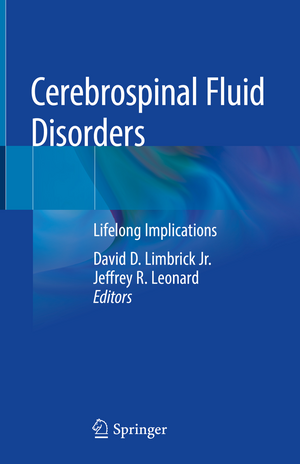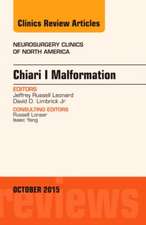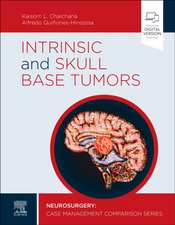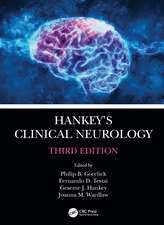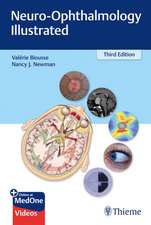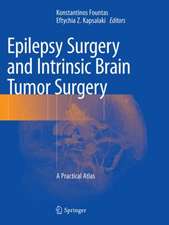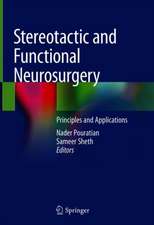Cerebrospinal Fluid Disorders : Lifelong Implications
Editat de David D. Limbrick Jr., Jeffrey R. Leonarden Limba Engleză Hardback – 19 noi 2018
This text is designed to present the current treatments for hydrocephalus across the lifespan. The foundation for understanding cerebral spinal fluid (CSF) abnormalities begins with the understanding of physiology and pathogenesis of disease. These chapters are written by published experts in the field and detail the significant advances in the detection of CSF abnormalities. This section will discuss the current advances in imaging and current research in biomarkers for both pediatric and adult patients. We will then systematically discuss the treatment of both pediatric and adult CSF disorders. These will be broken down by cause, since the physiology of each can be different. We will end the book with a discussion both of the technological advances and a discussion of consortiums and how they have advanced treatment of this chronic disease.
Preț: 869.48 lei
Preț vechi: 915.24 lei
-5% Nou
166.43€ • 180.84$ • 139.89£
Carte tipărită la comandă
Livrare economică 17-23 aprilie
Specificații
ISBN-10: 3319979272
Pagini: 415
Ilustrații: XII, 387 p. 74 illus., 36 illus. in color.
Dimensiuni: 155 x 235 x 20 mm
Greutate: 0.91 kg
Ediția:1st ed. 2019
Editura: Springer International Publishing
Colecția Springer
Locul publicării:Cham, Switzerland
Cuprins
Physiopathology of Foetal Onset Hydrocephalus.- Iron and Hydrocephalus.- Cerebrospinal Fluid Biomarkers of Hydrocephalus.- Intracranial Pulsatility, Cerebrospinal Fluid Flow and Glymphatic Function in Idiopathic Normal Pressure Hydrocephalus.- Congenital Hydrocephalus.- Genetics of Hydrocephalus: Causal and Contributory Factors.- Anatomy and Physiology Based Magnetic Resonance Imaging in Hydrocephalus.- Post-Hemorrhagic Hydrocephalus.- Multiloculated Hydrocephalus: Diagnosis, Treatment, and Clinical Implications.- Hydrocephalus Secondary to Spina Bifida.- Hydrocephalus and Brain Tumors.- Idiopathic Normal Pressure Hydrocephalus.- Hydrocephalus following Aneurysmal Subarachnoid Hemorrhage.- Post-Traumatic Hydrocephalus.- Management of Intracranial Hypotension and Cerebrospinal Fluid Leaks.- Cerebrospinal Fluid Shunting.- Shunts and Shunt Malfunction.- Endoscopic Third Ventriculostomy with Choroid Plexus Cauterization (ETV-CPC) versus CSF Shunting.- Randomized Clinical Trials in Pediatric Hydrocephalus.- Global Perspectives on the Treatment of Hydrocephalus.- Technical Advances in the Treatment Hydrocephalus: Current and Future State.
Recenzii
Notă biografică
Textul de pe ultima copertă
This book is designed to provide the current state-of-the-field for CSF disorders that occur across the lifespan. The authors of the following chapters are true content experts and provide their accumulated knowledge, experience, and wisdom in addition to a thoughtful view forward. We begin with a discussion of the ventricles themselves, with changes in the ependyma that occurs throughout development and as the brain matures and then ages. Pathophysiological changes and their role in hydrocephalus of various etiologies are considered. Alterations in CSF composition, physiology, and flow are also discussed in the context of neurodevelopment and neurodegeneration.
Caracteristici
Presents the current treatments for hydrocephalus across the lifespan.
Written by experts in the field.
Descriere
Hydrocephalus is one of the most common diseases of pediatric and adult neurosurgery. With the introduction of modern neurosurgical procedures, this disease has become a life-long problem. Even with optimal treatment, there is still significant morbidity and mortality along with a significant cost to the medical system. This has caused patients and their families to demand improvements in treatments and forced clinicians to evaluate their treatments in large consortiums while utilizing both genetics and technology to improve outcomes or avoid placement of shunt all together.
This text is designed to present the current treatments for hydrocephalus across the lifespan. The foundation for understanding cerebral spinal fluid (CSF) abnormalities begins with the understanding of physiology and pathogenesis of disease. These chapters are written by published experts in the field and detail the significant advances in the detection of CSF abnormalities. This section will discuss the current advances in imaging and current research in biomarkers for both pediatric and adult patients. We will then systematically discuss the treatment of both pediatric and adult CSF disorders. These will be broken down by cause, since the physiology of each can be different. We will end the book with a discussion both of the technological advances and a discussion of consortiums and how they have advanced treatment of this chronic disease.
